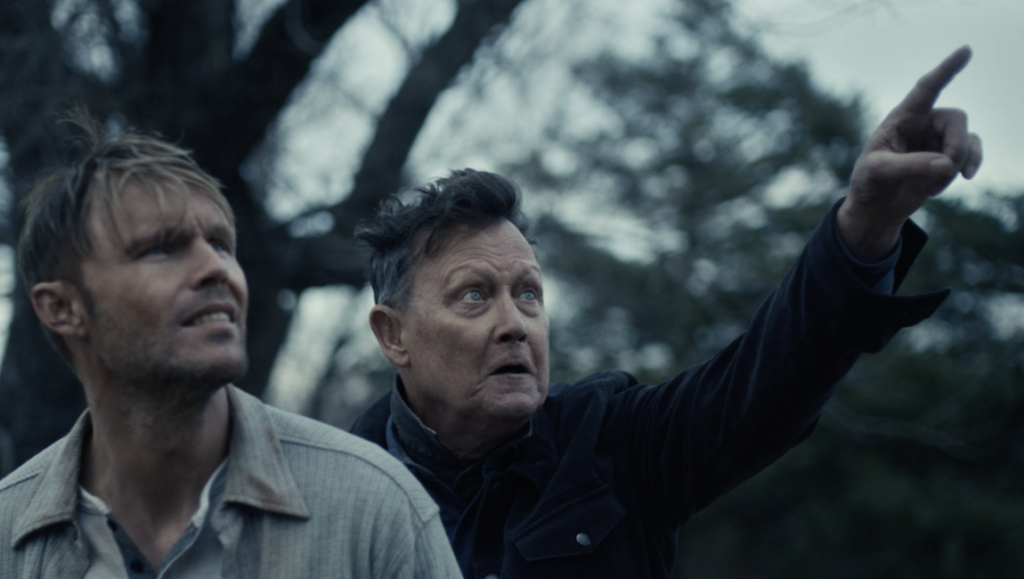What Josiah Saw exhibits Grashaw’s considerable formal chops, but there’s an inherent silliness pestering its core and its ending undermines some of its power.
The past strikes back with a vengeance in What Josiah Saw, a country-fried slice of Southern gothic that plays like Tennessee Williams by way of James Wan. Director Vincent Grashaw and first-time screenwriter Robert Alan Dilts have crafted an ambitious tale of familial strife and long-buried secrets that is surprisingly epic in both scope and execution, a sheen of prestige momentarily distracting from its over-familiarity and the melodramatic silliness at its core. Divided into four chapters, What Josiah Saw focuses on the Graham family, a broken unit whose farmland in Oklahoma is highly sought after by a big oil company, resulting in its dysfunctional members reuniting after years of separation.
Let’s set the stage. The film’s first section focuses on patriarch Josiah (Robert Patrick), a hard-drinking, temperamental blowhard who still lives on the farm with his simple-minded son, Thomas (Scott Haze). One night, Josiah is visited by the ghost of his wife, who hung herself in the tree in the front yard 23 years prior, and whose body is buried beneath its roots. She informs him of a special task he must perform, one that will apparently free her from eternal hellfire. He employs Thomas in his preparations, even as the details remain vague. In section two, we catch up with the other Graham male heir, Eli (Nick Stahl), an alcoholic, drug-addicted gambler and recent parolee who owes money to local baddie Boone (Jake Weber). He gets involved in an elaborate heist scheme involving “gypsy gold,” while a missing 9-year-old girl also works her way into the events. And section three follows Eli’s twin sister Mary (Kelli Garner), a damaged soul suffering from severe emotional and psychological trauma who is desperate to adopt a child with her estranged husband, Ross (Tony Hale). All of these various threads converge in the film’s final act, as the family is finally reunited in the name of personal and corporate greed, the fallout from which may make recovery impossible.
From the opening moments, Grashaw is keen to establish his film as serious and high-minded, a mode of austerity pervading the proceedings and bringing to mind something like the recent works of Ari Aster. Aerial shots of barren farmland are besieged by a blue filter, while sharp and dissonant strings fill the soundtrack and the mournful wails of a children’s choir occasionally texture the background. There’s to be no confusion that What Josiah Saw is a haunted film about a haunted family, and Grashaw and Dilts seemingly have no patience for levity. The atmosphere is oppressive, almost suffocating, but quite purposely so, and Grashaw shows an assured hand in commanding both tone and attention. It’s unfortunate, then, that the script lets the director down, even as it allows him to indulge his obvious strengths as a filmmaker, but it’s evident that Dilts is indeed a first-time screenwriter, as the story feels too overstuffed by half, the work of an artist who feels the need to get every idea out on paper, at the expense of cogency and flow. There’s enough going on within Eli’s storyline alone to make another entire feature if so desired. At 45 minutes, his section is by far the longest of the film, and while the heist sequence—including an extended bit involving a fortune teller—is legitimately thrilling and well-executed, it only digresses from rather than adds to the central storyline, and is thematically tangential at best. It also succeeds in hampering the development of Mary, who is afforded a scant 15 minutes, although in fairness, it doesn’t seem that Dilts’ strengths particularly lie in excavating the female psyche. There’s a scene involving Mary and a psychologist that is so downright bonkers — its results even more so — that one ponders if Dilts has any familiarity with the adoption process outside of soap opera storylines.
Much of that is to say that there’s an inherent silliness at the heart of What Josiah Saw, one that Grashaw desperately tries to paper over with an impressive combination of artistry and force of will. That he succeeds to the degree that he does is a testament to his raw talent, even as he goes to the “camera slowly pushes in on actor/object/location” well a few too many times in generating scares. But there’s still a palpable sense of tension that Grashaw creates and sustains throughout, effectively building to a climax that delivers the goods — until it doesn’t. Lesson to be learned: Just because you can doesn’t mean you should. The final moments of What Josiah Saw seem especially gross, a cheap bid at shock value that rings hollow and scans as a juvenile, further reinforcing the film’s streak of camp. In his best efforts to counter this, Grashaw also elicits some strong performances from his cast, especially Stahl, who has a face that was made to play “troubled and haunted.” (After this and his recent standout turn in the underrated Hunter/Hunter, a Stahl renaissance wouldn’t be an unwelcome development). What Josiah Saw is ultimately a conflicted film, one that finds its director doing his best to overcome deficiencies with technical prowess, producing images and moments that rattle in the brain even days later. Hollywood will come calling for Grashaw, that much is certain.
You can stream Vincent Grashaw’s What Josiah Saw on Shudder beginning on August 4.
Originally published as part of Fantasia Fest 2021 — Dispatch 4.


Comments are closed.